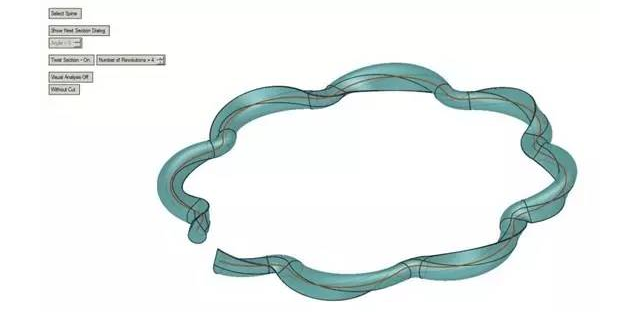With injection mold for manufacturing shaped cooling water is a hot topic in the field of 3D printing, 3D printing technology to manufacture a cooling water to avoid cross-drilled limit, 3D conformal cooling water can also be printed according to the cooling requirements of the different cooling The circuit is designed to dissipate heat at a consistent speed to promote uniformity of heat dissipation. Among some mold manufacturers, the conformal cooling mold business has accounted for 40% of the total business.
So, what is the difference between the design principle of the 3D printing conformal cooling waterway and the traditional cooling waterway? What can be learned from the design and manufacture of traditional cooling waterways? Xiaobian sums up the following points. The design experience shared by mold additive manufacturing experts will bring some inspiration to these issues.
The diameter of the waterway. Conventional cooling waterways manufactured using drilling methods are typically 7/16 inch (about 11.11 mm) in diameter. A cooling water path manufactured in this way, if the diameter is too large, may cause the water path to be difficult to access the mold surface while avoiding the mold part. If the diameter is too small, bit drift may occur during waterway processing. Although additive manufacturing techniques circumvent some of the limitations of drilling methods, it is still necessary to set the diameter within the proven range of commonly used sizes when designing waterways, thereby reducing the uncertainty of this technique.

Figure 1 The left picture shows the cooling water circuit processed by the traditional drilling method, and the right picture shows the cooling water path. The cooling time of the traditional cooling water circuit is 50.89 seconds, and the cooling time of the cooling water path is 44.97 seconds, which is reduced by 12%.
Cross-sectional area. When the cooling water circuit is machined by drilling, the cross-sectional area of ​​the water path is always constant. Although a water path with many different shapes can be manufactured by 3D printing technology, the cross-sectional area of ​​the water path should be kept constant when designing the 3D printing conformal cooling water path, thereby ensuring a constant volume of cooling liquid to pass through the water path.

Figure 2 is a cooling water path with a teardrop shape. The diameter of the inlet and outlet is 7/16 inch (approximately 11.11 mm) and the cross-sectional area of ​​the teardrop shaped waterway needs to be consistent during design. In this case, the cross-sectional perimeter of the teardrop shaped waterway is 1.574 inches (approximately 39.93 mm), while the circumference of a conventional circular waterway of the same area is 1.374 inches (approximately 34.90 mm), teardrop shaped The cooling water path has a larger surface area to carry away heat from the mold.
The distance from the surface of the mold. There is no fixed rule for the distance between the cooling waterway and the mold surface. For example, some enterprises retain the distance that is designed to be equal to the diameter of the waterway, and some companies retain the distance twice the diameter of the waterway. For most conformal cooling waterways, the distance from the mold surface depends on the geometry of the part. When designing the distance from the mold surface, there is a principle to be followed so that the conformal water path and the mold surface are always at the same distance to achieve uniform cooling.
The length of the cooling waterway. When machining a cooling water circuit using drilling, if the debris generated during drilling is not emptied, bit drift or damage may occur. In this case, people will choose to make the cooling waterway design as short as possible. Although the conformal cooling water path is manufactured by 3D printing technology, there is no problem such as tool damage, but it is not recommended to design the water path too long. This is because the cooling water can enter and exit more quickly in the shorter cooling water path, making the heat distribution more uniform.
Another rule for cross-sectional area. Since a plurality of short cooling water passages can be more uniformly cooled, some conformal cooling water passages are designed according to the idea of ​​a capillary tube, that is, a large cooling water passage is divided into a plurality of small and short water passages, and then Import a large waterway. In this case, the sum of the cross-sectional areas of the plurality of small waterways should be equal to the cross-sectional area of ​​the inlet and outlet of the large waterway, thereby ensuring uniform flow of water and further reducing the risk of warpage.

Rotating structure. The amount of water in the mold cooling water passage is a factor that affects the cooling time of the mold. The larger the water volume, the shorter the cooling cycle time. Another influencing factor is water turbulence. Although the inner surface of the 3D printed conformal cooling water path is not polished, some turbulence is generated, but if the rotating structure is added at the time of design, more turbulence can be generated. For example, the cooling water circuit shown in Figure 3 is designed to add four rotating structures to the top circuit.
These design rules are not all the rules that need to be paid attention to in the successful 3D printing conformal cooling waterway. The mold manufacturing users should have a systematic understanding of the injection mold manufacturing when designing the 3D printing conformal cooling waterway. There are many lessons to be learned from the traditional mold cooling waterway design principles, which are the basis for the effective design of 3D printed conformal cooling waterways.
Reference materials:
3D Systems Application Engineer DAVID LINDEMANN,
Conformal Water Line Design Guidelines, MouldMaking Technology.
Optimal cooling design in injection moulding process – A new approach based on morphological surfaces
Foam Mattress,Twin Foam Mattress,Gel Memory Foam Mattress,Twin Memory Foam Mattress
Jiangsu Sleeptight Household Technology Co., Ltd. , https://www.sleeptightoem.com